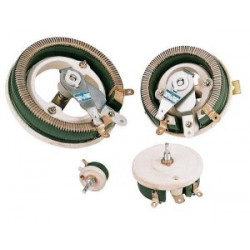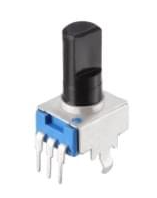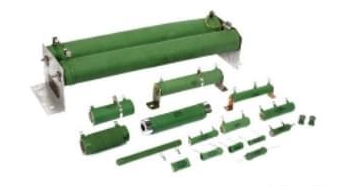What is a variable resistor?

The concept of variable resistor
Variable resistor, a resistor whose resistance can be adjusted, is used when the circuit current needs to be adjusted or the circuit resistance needs to be changed. A variable resistor can change the characteristics of a signal generator to dim a light, start an electric motor or control its speed. Depending on the purpose, the resistance material of the variable resistor can be metal wire, metal sheet, carbon film or conductive fluid. For currents of average size, metal type variable resistors are commonly used. When the current is very small, the carbon film type is used. The electrolytic type is most suitable when the current is high; the electrodes of this type of variable resistor are immersed in a conductive fluid.
In addition, a potentiometer is a special form of a variable resistor that balances an unknown voltage or unknown potential to measure the unknown voltage or unknown potential difference. The more commonly used potentiometer is simply a resistor with two fixed terminals, and the third terminal is connected to an adjustable brush. Another use of potentiometers is as sound control in audio equipment.
Basic functions of variable resistors
A variable resistor is first of all a resistor, which acts as a resistor in a circuit. But it is different from ordinary resistors in that its resistance can change continuously within a certain range. In situations where the resistance value needs to change but does not change frequently, it is recommended to use a variable resistor
It is an adjustable electronic component consisting of a resistive body and a sliding system. Variable resistors are mainly used to control the current in series circuits by changing their own resistance, thereby protecting some electrical components that require current levels. It is generally used in circuits that do not require frequent adjustment, and is mainly used to fix the resistance of the resistor to the same value. Additionally, variable resistors are often used in small signal circuits. A few places, such as tube amplifiers, recommend the use of large-signal variable resistors.
Depending on the application, the resistance material of the variable resistor includes metal wire, metal sheet, carbon film or conductive liquid. For currents of average size, metal type variable resistors are usually used. When the current is small, it is best to use the carbon film type. When the current is large, the electrolytic type is most suitable. Due to the structure and use of variable resistors, the failure rate is significantly higher than that of ordinary resistors.
circuit symbol for variable resistor
The diagram below shows the circuit symbol for a variable resistor. It is based on the ordinary resistor circuit symbol and uses arrows to represent its variable resistance characteristics. Two fixed pins and one moving pin can be identified from the circuit symbol. This is the latest variable resistor circuit symbol stipulated in national standards. The letters in RP stand for variable resistor.

Many existing circuit diagrams do not use this circuit symbol, but use the old circuit symbol shown in the figure below, which vividly demonstrates the principle of variable resistance adjustment and the actual connections in the circuit. Its movable leg is connected to a fixed leg, so that part of the resistance in the resistor body is short-circuited. The resistance of the variable resistor is the resistance of the resistor body between the movable leg and the other fixed leg. The variable resistor in Figure 2 uses only two pins.

The diagram below shows the circuit symbol for a variable resistor when used as a potentiometer. Clearly different from the picture above. Its three pins are independent. This is how to use a variable resistor with a potentiometer.

Typical structure of variable resistor
Knowing the structure of a variable resistor, you can easily analyze its working principle. The figure below shows the structure of a small signal variable resistor. As can be seen from the picture, it mainly consists of a moving plate, a carbon film body, and three pins. The three pins are two fixed pins and one moving pin. The moving plate of the variable resistor can rotate left and right. When we place a straight line, the contact points on the moving plate may slide on the resist or plate. Insert the screwdriver into the adjustment port and turn.

Use a slotted screwdriver to insert into the adjustment position. When the screwdriver turns clockwise or counterclockwise, the moving plate will rotate accordingly. When the moving piece rotates counterclockwise (the moving piece moves upward in the equivalent circuit), the length of the resistor between the fixed piece 1 and the moving piece decreases, and its resistance decreases. As the length of the resistor increases, its resistance increases.
When the movable plate rotates to the leftmost position (the uppermost end), the resistance value between the fixed plate 1 and the movable pin is zero, and the resistance between the fixed plate 2 and the movable pin is the largest, which is equal to the nominal resistance of the variable resistor, which is two resistance between the two fixed plates. When the moving plate slides to the far right (lowest end), the resistance value between the fixed plate 2 and the moving pin is zero, and the resistance value between the moving plate 2 and the moving pin is zero. plate and fixed plate 1 max, equal to the nominal resistance value.
Classification of variable resistors
Variable resistors can be divided into thin film variable resistors and wire-wound variable resistors according to materials;
1. Thin film variable resistor

Membrane variable resistors adopt a rotary adjustment method and are generally used in small signal circuits to control signal voltages, etc.
Membrane variable resistors usually consist of a resistor (synthetic carbon film), a movable contact (a movable metal reed or a carbon contact), an adjustment component and three pins (or soldering lugs). Two of the fixed pins are connected to both ends of the resistor, and the other pin (center tap) is connected to the movable contact piece. Use a small slotted screwdriver to turn the adjustment component and change the contact position between the movable contact and the resistor body, thereby changing the resistance value between the center tap and the two fixed pins.
Membrane variable resistors have three structures: fully sealed, semi-sealed and unsealed.
fully sealed thin film variable resistor
Fully sealed thin film variable resistors are also called solid variable resistors. Its resistor body is made of carbon black, quartz powder, organic binder and other materials, which are then pressed into a plastic or epoxy resin substrate and polymerized by heating. The moving contacts are made of carbon contacts and the adjusting parts are made of plastic. The resistor body and the moving contact are sealed with a metal shell, and there is an adjustment hole on the top. It is adjustable and has good dust-proof performance, and there is rarely a bad contact.
Semi-hermetic thin film variable resistor
The resistor manufacturing process of semi-sealed thin film variable resistors is basically the same as that of fully sealed variable resistors. The moving contact uses a metal reed, and the outer plastic cover is sealed. When the plastic cover rotates, the moving contact also rotates. This type of variable resistor is easy to adjust, but its dustproof performance is not as good as that of a fully sealed film variable resistor.
Unsealed Thin Film Variable Resistors
Unsealed thin film variable resistors are also called chip adjustable resistors. The resistor is made of a suspension formed of carbon black, graphite, quartz powder, organic binder, etc., coated on a fiberglass board or bakelite. The moving contact uses a metal reed with an adjustment hole on it, and no separate adjustment element is provided. The dustproof performance is poor, the contacts are easily oxidized, and the contact with the synthetic carbon film is poor and easily damaged.
1.wirewound variable resistors

Wirewound variable resistors are power type resistors with the advantages of low noise, high temperature resistance, and large current carrying capacity. They are mainly used for voltage or current regulation in various low-frequency circuits.
High power wirewound varistors are also called sliding wire variable resistors. It is further divided into axial porcelain tube wound variable resistors and porcelain plate wound variable resistors.
Low-power wire-wound variable resistors include circular vertical wire-wound variable resistors, circular horizontal wire-wound variable resistors and square wire-wound variable resistors, all of which are fully sealed packaging structures.
Variable resistor appearance characteristics
The variable resistor is very different from ordinary resistors in appearance. It has the following characteristics. According to these characteristics, the variable resistor can be identified in the circuit board:
1 The volume of the variable resistor is larger than that of the general resistor. At the same time, there are fewer variable resistors in the circuit, so it can be easily found on the circuit board.
2 The variable resistor has three pins in total. These three pins are different. One is the moving pin, and the other two are fixed pins. Generally, the two fixed pins can be used interchangeably, and the fixed pins can be used interchangeably. They cannot be used interchangeably with the moving pins.
3. There is an adjustment port on the variable resistor. Use a flat-blade screwdriver to insert into the adjustment port. Turn the screwdriver to change the position of the moving piece and adjust the resistance value.
4 The nominal resistance value can be seen on the variable resistor. This nominal resistance value refers to the resistance value between the two fixed piece pins, and also the resistance value between a certain fixed piece pin and the moving piece pin. the maximum resistance value.
5 Vertical variable resistors are mainly used in small signal circuits. Its three pins are vertically downward and installed vertically on the circuit board. The resistance adjustment port is in the horizontal direction.
6 Horizontal variable resistors are also used in small signal circuits. Its three pins are at 90° to the resistor plane, vertically downward, and installed horizontally on the circuit board, with the resistance adjustment port facing upwards.
7 The variable resistor in the small plastic shell is smaller and has a circular structure. Its three pins are downward and the resistance adjustment port is upward.
8 Variable resistor (wire-wound structure) used in high-power situations. It is very large and the moving piece can slide left and right to adjust the resistance.
edit author:

Jinftry(Hong Kong registered company name: JING FU CAI (HONGKONG) INTERNATIONAL CO., LIMITED) is an electronic parts distributor selling latest electronic components including integrated circuits, IC electronics, IC integrated circuits, IGBT, IGBT modules, button battery LR44,discrete te semiconductors, circuit protection, capacitors, resistors, potentiometers, transformers, isolators, crystals , oscillators, resonators, power managers, connectors, switches, relays, sensors, optoelectronic devices, diodes, and various batteries. Welcome to purchase electronic components from brand manufacturers. To view the solutions, you can log in to https://www.jinftry.com/ for inquiries







